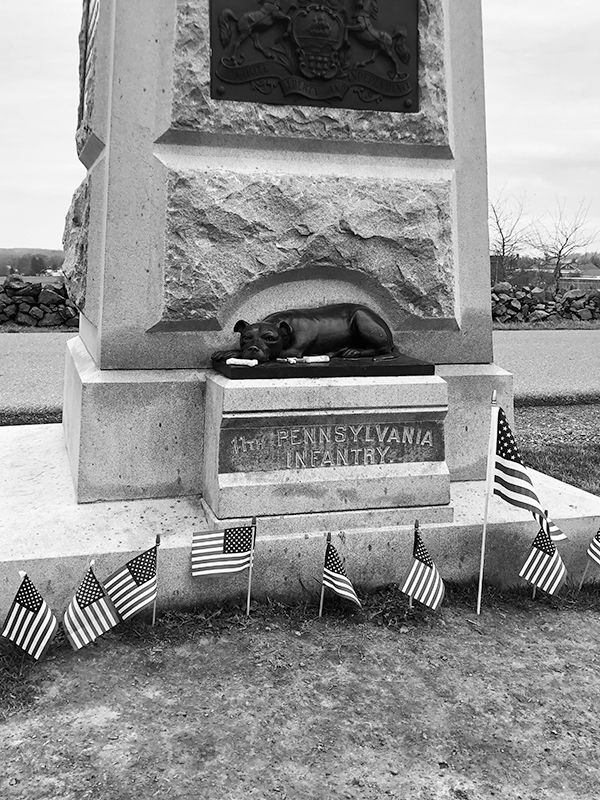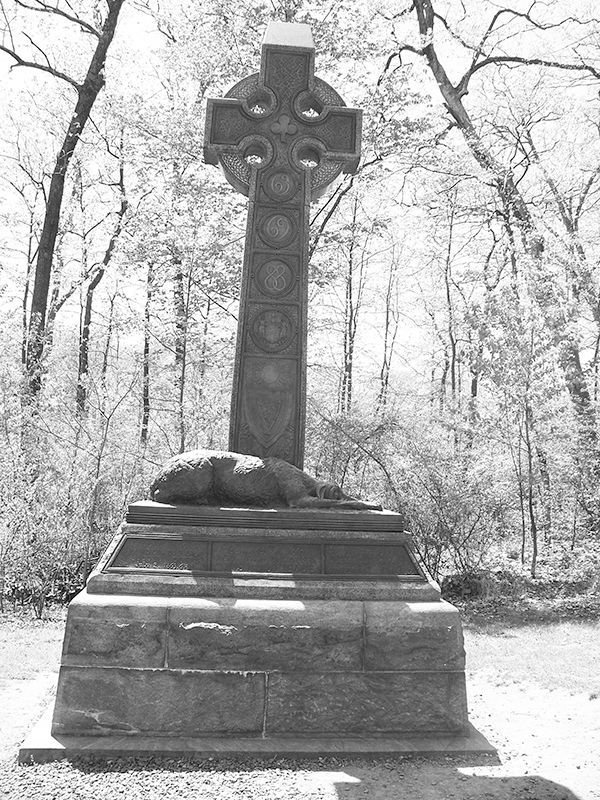Two Endearing Memorials: Gettysburg's Canine Monuments
by Diana Loski

Sallie, the mascot of the 11th PA Infantry
They are the Irish Brigade Memorial, located at the Loop near the edge of the Wheatfield, and the 11th Pennsylvania Infantry Memorial, located on General Robinson’s line just south of the Mummasburg Road and Doubleday Avenue intersection.
The Irish Brigade Memorial depicts the Celtic cross, beautifully crafted in bronze with the three Irish regiments from New York City: the 63rd, 69th, and 88th New York infantries. Two additional regiments fought with the Irish Brigade at Gettysburg: the 28th Massachusetts and the 116th Pennsylvania. All who served in this brigade were Irish immigrants who lived in those states at the time they were recruited.
The Irish Brigade was already the size of a large regiment rather than a brigade at Gettysburg, with about 530 in the ranks on July 2, 1863. Almost always in the thick of battle, the men from Ireland paid a stiff price for their temerity.
The Wheatfield battle was indeed a terrible one. Thousands fell in just a few hours in the late summer afternoon. The field of wheat was trampled with pools of blood collecting where the men in blue and gray had trod shortly before. One Irish soldier recalled, “ First the wheat fell, and then we fell.” 1

The Irish Brigade memorial
The Irish lost about half their number in a few hours in the Wheatfield.2
At the base of the Celtic cross lies an Irish Wolfhound, a demonstration of the soldiers’ devotion to the Union cause. On the back of the memorial, there is the incorrect statement that this breed of dog is extinct. Irish Wolfhounds are still very much in existence, although there was no particular Irish Wolfhound with the Irish Brigade at Gettysburg in the summer of 1863.
Gettysburg’s additional monument that depicts a beloved canine is found on the 11th Pennsylvania Memorial on Oak Ridge, just beyond the western edge of town. This monument pays tribute to an actual dog who was beloved by members of the regiment.
The 11th Pennsylvania was one of the earliest troops from Pennsylvania to enlist in the war for the Union. They first mustered in the spring of 1861 for three months. By August, they reenlisted for three more years. They were part of Brigadier General Henry Baxter’s Brigade, General John Robinson’s Division, General John Reynolds’s First Corps. They were toughened veterans by the time they fought at Gettysburg on July 1, 1863.3
The regimental mascot was Sallie, a Staffordshire terrier (commonly known as a pit bull), who was given to one of the men of the 11th Pennsylvania as a puppy. The entire regiment welcomed her and made her their adopted female of the unit.
Historian Jacob “Mett” Sheads, a well-known professor and battlefield guide said of Sallie: “ She hated women because she was a man’s dog. She hated Confederates because she was a Union dog. She hated politicians, because she was a soldier’s dog.”4
Sallie was devoted to her boys of the 11th Pennsylvania. She woke them at reveille. She stayed with them on the front lines, barking furiously at the Confederates as the Union boys fired at will. She did the same at Gettysburg, near the spot where the memorial stands.
On the afternoon of July 1, 1863, as the Confederate troops crossed the field known today as Iverson’s Pits, General Baxter ordered his brigade to fire upon the advancing men in gray and butternut, causing many to fall. The battle remained sore as Southern reinforcements from General Richard Ewell’s corps arrived, flanking the men on the ridge and endangering their position. Many of the 11th Pennsylvania fell wounded or killed, and in the ensuing melée the survivors retreated quickly through the town and took refuge on Cemetery Hill. The survivors were placed on Culp’s Hill for the remainder of the fight.
Days later, as the Army of the Potomac left Gettysburg in pursuit of Lee’s retreating army, soldiers from another regiment in Baxter’s Brigade brought Sallie to the 11th Pennsylvania. She had remained with the wounded and the dead of her regiment, refusing to eat for several days.5
Sallie continued the fight with her boys from Pennsylvania, until she was killed in the Battle of Sayler’s Creek in February 1865. In spite of the danger of being shot, the soldiers buried her on the field. She was just four years old.6
Today, Sallie is memorialized in bronze at the base of the 11th Pennsylvania Monument. She rests as she did after the fight on July 1, 1863, guarding her boys.
Not only do these two memorials pay homage to the courage of sacrifice of the boys in blue at Gettysburg, but they also remind us of our canine companions, who have endeared themselves to us over the ages, and for good reason, for whatever good or bad befalls us.
Sources: The 11th Pennsylvania File, Gettysburg National Military Park (hereafter GNMP). Murphy, T.L. Kelly’s Heroes: The Irish Brigade at Gettysburg . Gettysburg, PA: Farnsworth House Military Impressions, 1997. Interview with Col. Jacob M. Sheads, April 11, 1998. Gettysburg:stonesentinels.com. Additional information found on the 11th PA and Irish Brigade Memorials.
End Notes:
1. Murphy, p. 30.
2. Ibid., p. 38. The numbers vary from 220 casualties to 330, depending on the source. Ms. Murphy’s numbers coincide with Gettysburg National Park numbers.
3. The 11th Pennsylvania File, GNMP. Gettysburg.stonesentinels.com.
4. Interview with Col. Sheads (1910-2002), Apr. 11, 1998.
5. 11th PA File, GNMP.
6. Ibid.
The 11th Pennsylvania Monument is located on Doubleday Avenue, past the tower and before the Doubleday Inn. Sallie faces the field and not the road. The Irish Brigade Monument is found on the Loop just past the Wheatfield on Sickles Avenue. It can be reached by following Ayres Avenue through the Wheatfield or Crawford Avenue through Devil's Den and then straight through the Wheatfield. The memorial will be seen on the left where the tree line begins.


